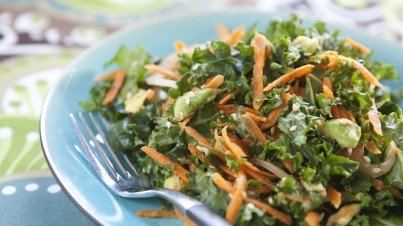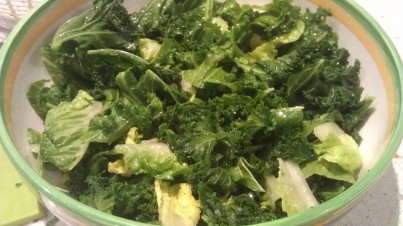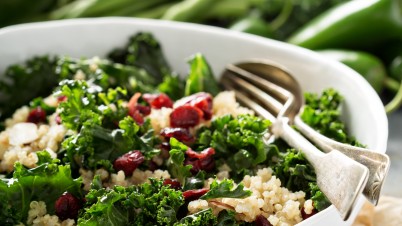Kale is a leafy cabbage that does not form a head. It’s a member of the Brassica genus, alongside Broccoli, cabbage, cauliflower, and Brussels sprouts, mustards and oil-seed plants, like canola. Kale is considered closer to wild cabbage than other domesticated species of Brassica oleracea
How to prepare
Kale cops a bad rap in the veggie world, and this is mostly due to dodgy prep work! Kale can be tough if you don’t treat it right – but it’s hardy, strong leaves are great for so many reasons. The strong leaves help it stand up to the harshest growing conditions, help our digestion, and retain structure even when you cook it for too long, or need to reheat it.
Grab a fresh bunch of kale and wash it well, get prepped with a sharp knife, chopping board and bowl.
Removing the stems
Leaves and stems of kale need to be treated differently, so always remove the stem. Fold the leaf in half, holding it down to expose the stem and slice along.
Chopping kale
Leaves: If you’re sautéing or adding to soups or stews, shredded kale is fantastic. Long, thin pieces hold their structure well and won’t leave you chewing. Fold the leaves together and then roll them up, chopping lengthways to create long, thin strips. If you find kale bitter, giving it another rinse with cold water after you’ve chopped it will reduce the bitterness.
Stems: If you choose to use the stems, slice them super finely into little rounds. You can add them raw to a salad for some crunch, or straight into your stew on the stove to let them soften up.
Cooking with kale
Sauté: If you’re chucking it straight in the pan to fry up or steam as a great big bowl of greens, heat some oil and garlic, chuck in the kale and add lemon juice, salt and pepper. The lemon juice will help it retain the vibrant green and give it a fresh zing.
Stew: If you’re cooking soup or stew, put it in the pot about 10 minutes before serving. It takes longer to cook than other greens like spinach or silver beet.
Roast: Roasting kale doesn’t do it any favours. It tends to get tough and dry. I would avoid roasting it unless you want to try your hand at crispy kale chips.
Raw: You can eat kale raw in all sorts of salads. You can mix it through a warm roast salad for a fantastic splash of green – especially good in potato salads. For a cold salad, if your leaves are a bit tough you can give them a massage! While they are on the chopping board, or in the bowl, grab your dressing and massage it into the leaves. This will soften them dramatically and make them taste great!
Buyer's and storage guide
Buying
Kale is in season year-round, you can generally source different kinds of kale at any time through the year. There are two main options for buying kale, in bunches – sometimes in plastic sleeves, and pre-cut in bags.
Different types of Kale will have different leaf qualities to look for. Hardier curly Kale should be crisp looking, and the softer Tuscan kale and cavolo nero should look fresh and plump. Look for a bunch with unblemished leaves, without holes. Avoid bunches with limp, wilting or yellowing leaves. You can also check the stalks, especially if they are in a plastic sleeve. If they are dry and splitting, the kale might be tougher. Make sure they’re not mushy or soft.
The colours vary between types but generally should be a lush green. Curly kales are brighter and lighter than the dark, almost blue hues of cavolo nero. Stripes and tinges of purple are normal, especially in baby-leaf kale.
Storing
Store Kale in the fridge, it can get bitter if it is left out at room temperature.
It's best stored dry, in the crisper. If your raw kale is fresh, it will last well in the fridge for a week. If it’s a bit older and gets limp, it can still be eaten – but will be much better shredded and cooked. Store in an air-tight bag can help if you need extra shelf life.
If it has black, white or rust-coloured specks on the foliage, is slimy or has a sulfuric twang - it’s time to put it in the compost.
Cooked kale keeps for around 3 days in the fridge.
You can also freeze kale! Much like spinach, you can blanch and ice the leaves, then quick-freeze the spread-out leaves on a baking tray in the freezer, before compacting them into an air-tight freezer bag. Great if you’ve grown excess or want something green on hand to chuck in soups and stews.
Serving
- Add to many vegetable dishes such as mashed potatoes
- Freshly sliced leaves can be added to salads; combines well with grated carrot, beetroot and toasted nuts
- Add to any form of casserole or stew, and is commonly used with smoked meats
- Blend with some cream and cheese for a winter sauce
- Stir-fry in a pan with some onions, tomatoes, capsicum and olive oil



